
|
|

February 20, 2009
XEWT, Tijuana
One of the truly fun parts of doing "Tower Site of the Week" is the unusual invitations it brings our way. Our April 2008 pre-NAB swing through southern California was particularly remarkable in that respect - as you'll see in future "Site of the Week" installments, it brought us everywhere from the World's Shortest Blaw-Knox Diamond Tower to the last remaining rooftop "hammock" AM antenna to the unique operation we showed you last week: the cross-border TV legend that is XETV, channel 6, licensed to Tijuana, Baja California, Mexico and serving all of sunny San Diego.
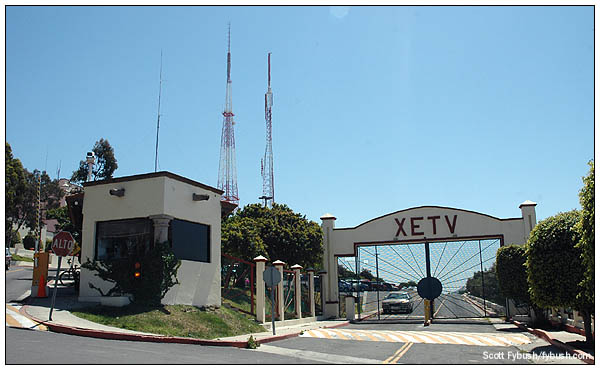
But it turned out that after XETV's Gary Stigall and Bob Anderson treated us to a tour of Channel 6's Tijuana operations, there was yet another treat in store - the chance to go next door to see the very impressive facilities of the other station that shares the top of Mount San Antonio: XEWT, channel 12.
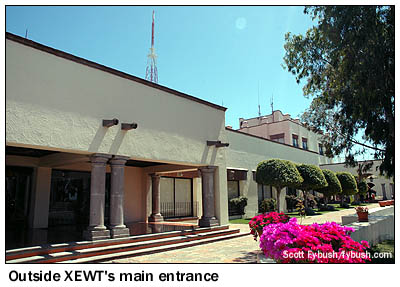 |
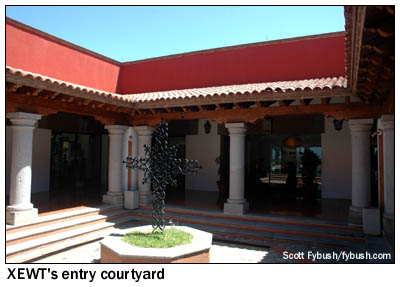 |
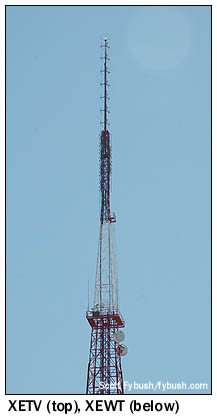 When
XEWT came on the air in 1960, it was the second TV station licensed
to Tijuana, but the first to broadcast in Spanish to local viewers.
When
XEWT came on the air in 1960, it was the second TV station licensed
to Tijuana, but the first to broadcast in Spanish to local viewers.
The "XEW" in channel 12's callsign is very significant, since it's a direct reference to Mexico's oldest and largest radio station, XEW in Mexico City - and XEWT ("T" for Tijuana, and perhaps also for "television") was, and still is, owned by the Azcarraga family, which controls Televisa, Mexico's largest broadcasting company.
I'm not certain where XEWT was when it began, but I don't think it was here on Mount San Antonio. Early pictures of the mountaintop over at the XETV building show a lot of empty space, and the XETV tower shown in those pictures is quite certainly not the present 500-foot self-supporter at the south end of the property that holds analog antennas for channels 6 and 12.
(I've heard references to an XEWT facility near the Agua Caliente racetrack, a few miles to the east of the Mount San Antonio site, and would certainly appreciate hearing from readers with more specific knowledge; history of Mexican broadcast facilities is nowhere near as easy to find online or in my reference books as it is for U.S. stations.)
In any event, the current facility XEWT occupies atop Mount San Antonio is certainly much more recent than 1960, appearing to date from the nineties or thereabouts, though its exterior is designed to suggest a Spanish mission from several centuries prior.
With chief engineer Salvador Hernandez as our guide, let's head inside and see this enormous broadcast facility, where the spirit of local television that died out north of the border sometime in the seventies is still alive and thriving...
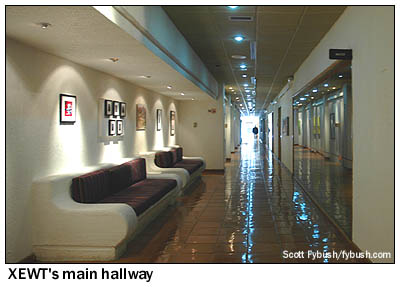 |
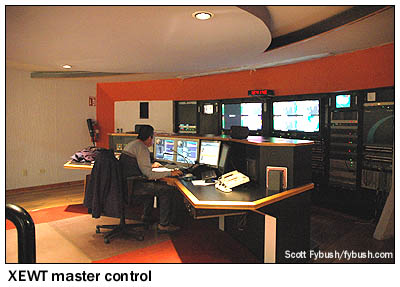 |
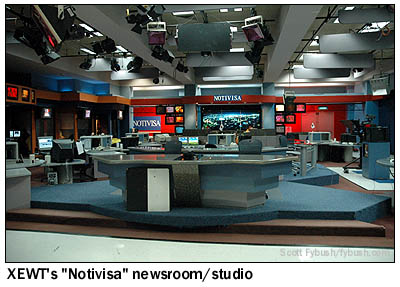 Even
the approach to XEWT's lobby is impressive; we enter through
a shady courtyard, where doors adorned with Televisa's "eye"
logo lead in to the tiled lobby.
Even
the approach to XEWT's lobby is impressive; we enter through
a shady courtyard, where doors adorned with Televisa's "eye"
logo lead in to the tiled lobby.
XEWT's administrative offices lie to the left of the lobby, with sales offices straight back, but our tour begins down the long tiled hallway to the right, which leads to the station's operations area, studios and newsroom.
Behind the walls on the left side of the hallway are the studios, which we'll see in a moment. That glass wall on the right looks in to master control, where an operator handles not only XEWT itself but its Televisa sister stations, XHBC (Channel 3) in Mexicali, 80 miles or so to the east, and XHS (Channel 23) in Ensenada, 50 miles or so to the south. Both stations simulcast XEWT's programming, but carry local ads; they also operate local newsrooms that feed stories to Tijuana for XEWT's "Notivisa" newscasts, which originate in the big studio/newsroom across the hall from master control three times daily, from 7-8 AM, 6-7 PM and 10-11 PM.
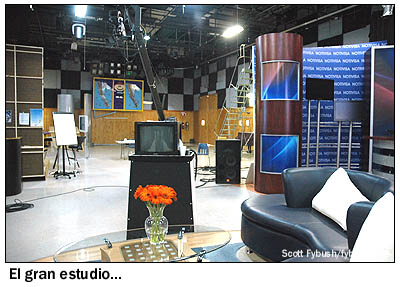 |
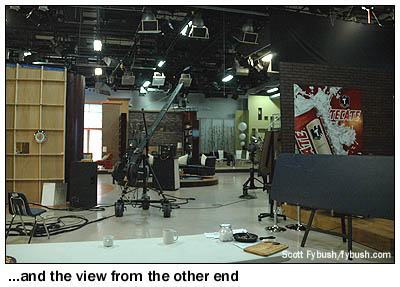 |
The "Notivisa" newsroom/studio adjoins an even bigger studio, home to much of XEWT's local programming. "Notivisa Buenas Dias" is the local morning show that airs from 8-10 on weekdays, and its multiple sets, including a full kitchen and living-room area, take up one end of "el gran estudio." At the other end, a big wooden stage is home to the "Tecate" music show (named after - and sponsored by - the beer, of course) that airs on Saturday nights.
There's a second studio down the hall from this one that's apparently vacant at the moment, but which is often used for national productions; at one point, Televisa operated a Mexican home-shopping network from here, and I believe the Mexican version of "Millionaire" may have taped here as well.
Down the hall from the studios, there's a huge scene shop where the sets for all this local and national production are built.
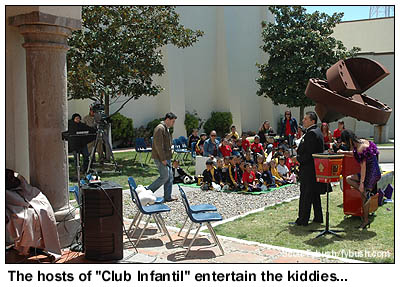 |
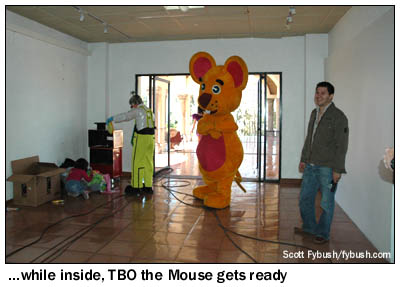 |
But wait - there's more! Remember the days when every local TV station had its own kiddie show each afternoon, where a local host would tell jokes and do magic tricks before an audience of wide-eyed local youth, interspersed with old cartoons and whatnot? Those shows are long gone in the U.S., but they live on here in Tijuana, where we find a taping of "Club Infantil" in progress on the lawn out front - and the show's mascot, TBO the mouse, getting ready inside for his big entrance!
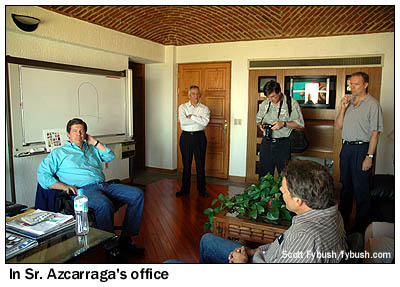 |
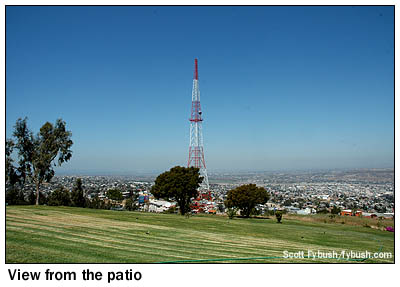 |
After our tour, we're invited back to the other end of the building to meet XEWT's general manager, Ricardo Azcarraga Lopez, in his suite of offices, where he enjoys the dramatic view to the north over Tijuana and, on a clear day, to San Diego beyond. That's Salvador Hernandez standing by the door, XETV's Bob Anderson at far right, and several other members of our traveling party enjoying the conversation.
(The view from Mount San Antonio also includes the competition: that tower visible from the front lawn belongs to XHAS, channel 33, the Telemundo affiliate that's aimed primarily at the Hispanic audience across the border in San Diego; scroll back up to the picture of XEWT's main entrance near the top of the page and you'll see yet another tower on the eastern edge of Televisa's property, belonging to competitor TV Azteca and used by its Tijuana stations. We'll show you a closeup of that tower next week.)
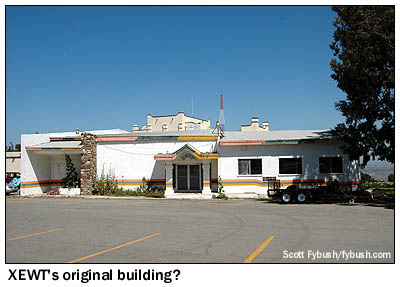 |
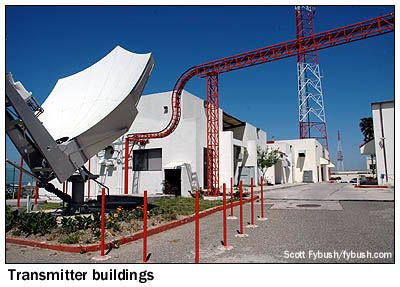 |
With many thanks to Sr. Hernandez and Sr. Azcarraga for their gracious welcome, we head out of the XETV/XEWT compound to get lunch - but first, let's jump back a bit in the tour and show you a few more highlights we'd seen earlier in our visit.
That building above left sits just south of the big new XEWT building, across the parking lot from XETV's building, and I think it may be an earlier XEWT transmitter building; in any event, it appears to be vacant now. XEWT's present analog transmitter sits behind the XETV building, at the extreme southern end of the Televisa property, and we didn't get to see that.
We did, however, get to see the transmitter buildings just west of the XETV building, which house the rest of Televisa's transmitters up here.
XEWT-DT (Channel 32) shares a room with XETV-DT (Channel 23), though as a newer signal, XEWT uses a Harris Diamond CD transmitter instead of XETV's early NEC transmitter. There's a second Diamond CD out of frame to the right of XETV-DT - that's XHUAA-DT (Channel 22), the digital signal of XHUAA, Televisa's Tijuana relay of its Mexico City flagship, XEW-TV (Channel 2).
(Televisa also has a Tijuana relay of another of its Mexico City signals; XHGC (Channel 5) is relayed on Tijuana's XHBJ (Channel 45). The XHBJ analog transmitter is apparently at a different tower site, and XHBJ-DT is not yet on the air, but the XHBJ programming is also seen on a subchannel of XETV-DT from this site.)
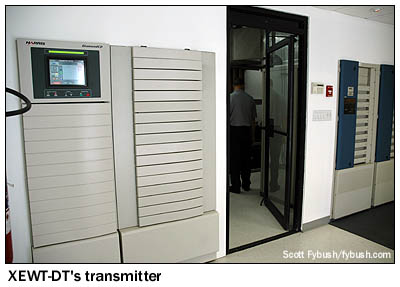 |
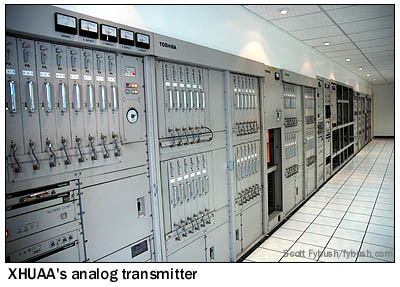 |
XHUAA's analog signal is on channel 57, and it emanates from what may be the biggest UHF transmitter we've ever seen, a Toshiba solid-state behemoth that literally fills a room next door to the DTV signals.
Those DTV signals and XHUAA's analog all feed antennas on the shorter of the two towers on the property; scroll back up to the wide shot at the top of the page, and you'll see the analog tower (channels 6 and 12) on the left and the DTV/XHUAA tower at the center.
It's a truly remarkable site, and we're most grateful for the chance to have visited it - and to have shared it with you!
- Previous Site of the Week: XETV, Tijuana/San Diego
- Next Week: More Tijuana/Rosarito Beach sites
- Site of the Week INDEX!
- How can you help support Site of the Week? Click here!
- Submit your suggestions for a future Site of the Week!
